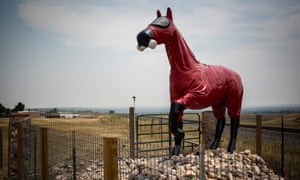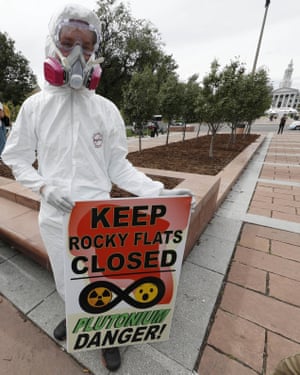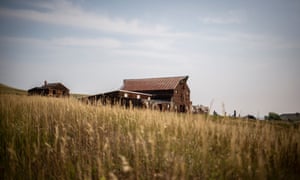Amid plutonium fears, schools ban visits to new Colorado wildlife refuge
A nearby town is suing over fears that the land, once home to a nuclear weapons facility, still poses a threat

The nation’s newest national wildlife refuge, filled with swaying prairie grass and home to a herd of elk, is slated to open next month just outside Colorado’s largest city.
But seven Denver metro area school districts have already barred school-sanctioned field trips to the preserve. A top local health official says he would probably never hike there. And a town is suing over what the soil might contain.
“The threat posed by contamination at Rocky Flats and its effect on visiting children appears to be an issue of dispute amongst experts,” Lisa Flores, a Denver public schools board of education member, told the Guardian. “Until we have definitive assurances of child safety, we will exercise an abundance of caution.”
The 2,119-hectare (5,237-acre) Rocky Flats national wildlife refuge, due to open this autumn, sits on land surrounding what once was a nuclear weapons production facility. From 1951 to 1989, the Rocky Flats Plant manufactured plutonium triggers – grapefruit-size spheres that, when compressed by explosives, catalyze a nuclear reaction.

Though the area, about 20 miles north-west of Denver, has been cleaned up and declared safe by the government, plutonium remains in the ground where the facility once stood.
Sightseers at the refuge won’t have access to the site of the demolished plant. The 526-hectare (1,300-acre) patch is fenced off, and the US Department of Energy monitors and manages the area. It’s the land surrounding the plant, a one-time buffer zone, that the US Fish and Wildlife service (USFWS) plans to open next month. “We rely on the science and the agencies that are responsible,” said the refuge manager, David Lucas. “We believe it’s safe for the public and all of our visitors.”
The buffer zone has remained largely untouched over the past half-century, and the minimal foot traffic has allowed flora and fauna to thrive. The refuge is home to more than 630 plant species and 230 animals, including the threatened Preble’s meadow jumping mouse and a 100-strong herd of elk. “The habitat and wildlife of this area are unique to the whole front range,” said Cynthia Souders, a USFWS supervisory ranger.
Yet some doubt the thoroughness of the cleanup.

After the plant was raided by the FBI and EPA in 1989 over possible environmental crimes, such as dumping toxic waste into drinking water, it was added to the EPA’s Superfund national priorities list. The Department of Energy originally estimated the cleanup would take 60 years and cost more than $30bn (£23.3bn). But the process, carried out by an independent contractor, only took 10 years and cost $7bn (£5.4bn). During that time, more than 800 structures were decontaminated and demolished; the refuge site was determined to need zero remediation.
The executive director of the public health department in Jefferson county, where the refuge is located, has his own doubts about the park’s safety. “If I honestly felt that the data showed the risks of hiking out there were very, very little, I wouldn’t fight them opening it,” said Mark Johnson. “I think it’s too convenient that the original [cleanup] estimate of 70 years and billions of dollars was cut so short and so cheap.”
Residents of Superior, a town of 13,000 people abutting the refuge’s north-eastern edge, are worried that hikers and bikers could track plutonium-laced dirt out of the refuge and are suing. “All of the risk assessment regarding plutonium was based on a very limited hiking utilization and work on the refuge by refuge employees, so we’re talking about stuff that was not going to generate much in the way of dust, was not going to disturb a lot of soil or subsurface. That has changed,” said Timothy Gablehouse, the attorney representing Superior.
The US Department of Justice declined to comment on the pending litigation. But a state environmental protection specialist, Lindsay Masters, said the concerns were overblown. “This is one the most of well-studied pieces of land on the planet. It was cleaned up in accordance with state and federal law and regulations. The risk [to visitors] is incredibly low.”
The public clearly has an appetite for visiting once-contaminated nuclear sites. The site of Rocky Mountain Arsenal national wildlife refuge, about 30 miles west, was used for weapons manufacturing during the second world war and the cold war. There are monthly public tours available of the Nevada national security site, a one-time nuclear test site located 65 miles north-west of Las Vegas. And twice a year, visitors can see where the world’s first atomic bomb was detonated: the Trinity site is a national historic landmark in New Mexico.

A judge will probably decide if Rocky Flats can join that list as two federal lawsuits asking for updated environmental analyses are currently moving through the judicial system.
On a recent visit, dozens of elk climbed out of a culvert, their calves following closely behind; their calls, carrying on the wind, sounded like seagulls. Prickly pear and barrel cactus dotted the ground, while swallows, yellowthroats, and meadowlarks soared above. Monarch butterflies fluttered between patches of hip-high pink milkweed.
And it was quiet – unexpectedly quiet for land surrounded on three sides by highways and enmeshed in a nuclear weapon-related dispute.
- This article was amended on 22 August. An earlier version called the Preble’s meadow jumping mouse an endangered species. The mouse is actually listed as ‘threatened’.

.png)






Follow Us!